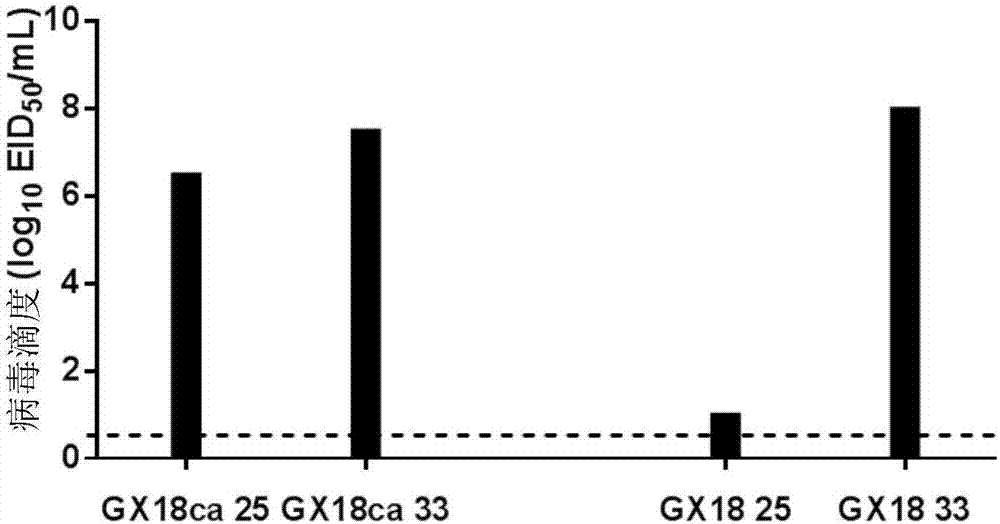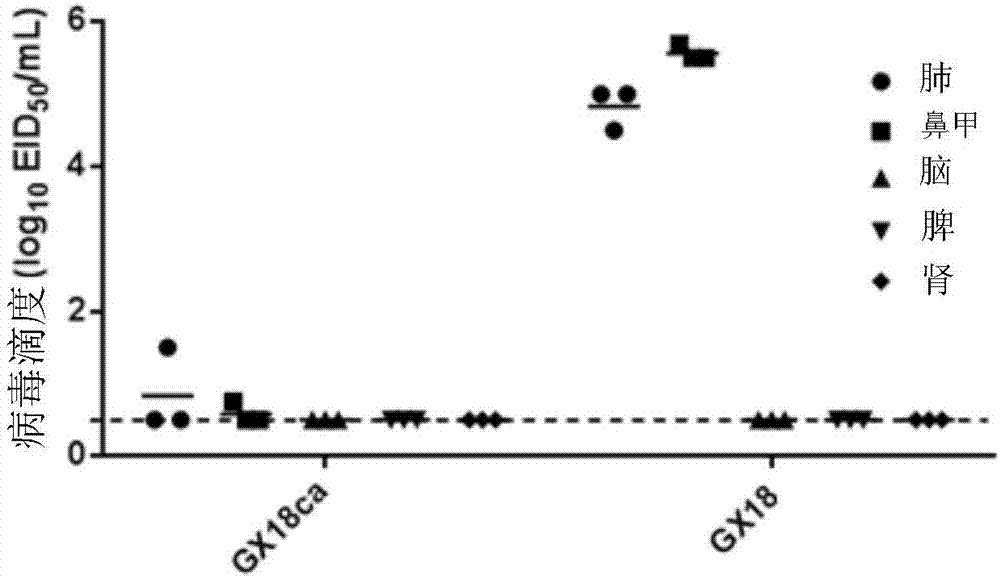Eurasian avian like H1N1 swine influenza A virus cold-adapted attenuated virus strain and application thereof
A technology for H1N1 and swine flu, applied in veterinary vaccines, antisense single-stranded RNA viruses, medical preparations containing active ingredients, etc., can solve problems such as long residual time and lack of virus cross-protection
- Summary
- Abstract
- Description
- Claims
- Application Information
AI Technical Summary
Problems solved by technology
Method used
Image
Examples
Embodiment 1
[0026] Example 1 Preparation of Eurasian avian H1N1 subtype swine influenza cold-adapted attenuated vaccine strain A / swine / Guangxi / 18 / 2011ca (H1N1)
[0027] 1. Take out one copy of the Eurasian avian H1N1 subtype swine influenza virus strain A / swine / Guangxi / 18 / 2011(H1N1) (GX18 for short) stored in our laboratory, dissolve it, and place it on ice to determine blood coagulation ( HA) price, and calculate 4HA unit / 0.2mL;
[0028] 2. 10-day-old SPF chicken embryo allantoic cavity was inoculated with 0.2 mL of GX18 virus diluent containing 4 HA units (diluted with phosphate buffer solution of pH 7.2 to 7.4);
[0029] 3. Incubate at 33°C for 72 to 96 hours and determine the HA value. When the HA value reaches 128 to 256, harvest the virus solution and use it as the next incubation temperature (1°C as the unit, gradient reduction) seed virus, continue to step 2 experiment.
[0030] In this way, 17 generations were uploaded on 10-day-old SPF chicken embryos, and a Eurasian avian H1N1 subtype...
Embodiment 2
[0035] Example 2 Determination of cold-adapted (ca) of swine influenza cold-adapted attenuated vaccine strain GX18ca
[0036] Cold adaptability (ca) is to compare the replication titers of virus strains on chicken embryos under 33°C suitable growth temperature conditions and 25°C low temperature growth conditions. Under the low temperature condition of 25℃, if the difference between the growth titer of the virus on the chicken embryo and the growth titer under the growth condition of 33℃ is within 100 times, the virus is considered to have cold adaptability characteristics, and vice versa .
[0037] Method: Dilute the virus GX18ca and the corresponding wild virus GX18 in a 10-fold ratio on ice, namely 100 μL virus + 900 μL PBS, and mix well. Pipette 100 μL of virus dilution into the next tube of 900 μL PBS, mix well, and then By analogy, dilute to 10 -9 . The diluted virus was inoculated with 4 10-day-old SPF chicken embryos for each dilution, and the inoculated chicken embryos w...
Embodiment 3
[0040] Example 3 Determination of temperature sensitive (ts) of swine influenza cold-adapted attenuated vaccine strain GX18ca
[0041] Temperature sensitivity (ts) is to compare the replication titer of virus strains on chicken embryos under suitable growth temperature of 33°C and high temperature of 39°C. If the growth titer of the virus on the chicken embryo under the high temperature condition of 39℃ is more than 100 times lower than its growth titer at the appropriate growth temperature of 33℃, then the virus is considered to have temperature sensitivity characteristics, and vice versa Of course.
[0042] Method: Dilute the virus 10 sequentially 2~7 To determine the EID of GX18ca and the corresponding wild virus GX18 at 33℃ or 39℃ 50 After 72 hours of incubation, the hemagglutination test was used to detect the replication of the virus at each temperature, and the Reed-Muench method was used to calculate the half of the chicken embryo infection dose (EID 50 ). The same metho...
PUM
 Login to View More
Login to View More Abstract
Description
Claims
Application Information
 Login to View More
Login to View More - R&D
- Intellectual Property
- Life Sciences
- Materials
- Tech Scout
- Unparalleled Data Quality
- Higher Quality Content
- 60% Fewer Hallucinations
Browse by: Latest US Patents, China's latest patents, Technical Efficacy Thesaurus, Application Domain, Technology Topic, Popular Technical Reports.
© 2025 PatSnap. All rights reserved.Legal|Privacy policy|Modern Slavery Act Transparency Statement|Sitemap|About US| Contact US: help@patsnap.com



